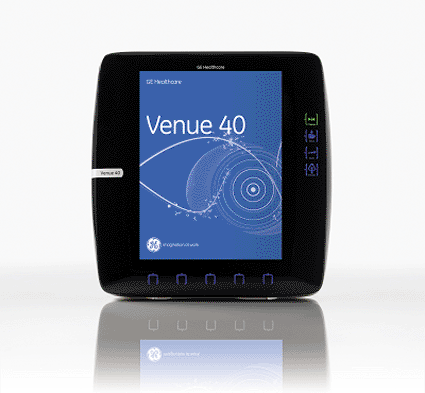Miniaturized, Portable Ultrasound Provides Rapid Diagnosis and Procedures at Patient's Bedside
By MedImaging International staff writers
Posted on 19 Oct 2009
A new miniaturized ultrasound system is portable, allowing physicians to quickly perform rapid diagnostics and needle-guided procedures at a patient's bedside, providing real-time results. Whether it is being used in the emergency room (ER), operating room (OR), or sports medicine clinic, the lightweight system can be easily transported from location to location, and provides high-resolution imaging, and is easy to both use and clean. Posted on 19 Oct 2009
Venue 40, with advanced touch-screen technology, was launched by GE Healthcare (Chalfont St. Giles, UK) and is the first new-to-market product validated under GE's "healthymagination” initiative, dedicated to improving the quality, access, and cost of healthcare. "The Venue 40 is a powerful, user-friendly ultrasound system that is helping to transform the patient experience by enabling doctors to deliver quality care at the patient bedside,” said Omar Ishrak, President and CEO of GE Healthcare Systems. "Services delivered at the point of care allow doctors to spend more time with their patients and can help enhance patient comfort and reduce anxiety. Venue 40 development is part of GE's commitment to driving efficiencies in healthcare through technology that helps yield more rapid diagnosis, improved patient experiences and better outcomes.”

Image: The Venue 40 miniaturized ultrasound system (Photo courtesy of GE Healthcare).
An intuitive touch screen and streamlined design that is free from buttons, knobs, or a keyboard make the system easy to use and clean. Its small size and sleek cart allows for real-time imaging in the smallest of clinical spaces, such as at the patient's bedside or in a trauma bay. Physicians can quickly dock the compact ultrasound in the cart or table dock, without tools, and effectively perform scans and needle guidance at the bedside, enhancing patient comfort.
"The Venue 40 provides an easy-to-use ultrasound system with great image quality to improve care for critically ill patients in the emergency department who need rapid diagnosis and procedural ultrasound guidance,” said Dr. John Bailitz, assistant professor of emergency medicine at Rush University Medical School (Chicago, IL,USA).
The system has the potential to increase patient access to ultrasound, which may help the patient experience by potentially avoiding painful tests, minimizing the number of procedure attempts, such as needle placement, and enabling care of complicated cases, such as patients who are obese, elderly, or critically ill.
"GE's Venue 40 ultrasound system is a major advancement,” said Dr. Jeff Swenson, professor of anesthesiology at the University of Utah and director of anesthesia at the University of Utah Orthopedic Center (Salt Lake City, UT, USA). "It's extremely user friendly and offers very precise images.”
The Venue 40 has five innovative applications, designed for specific procedures and diagnostic exams to meet the needs of various clinical settings: Vascular access, which allows placement of peripheral or central lines with exceptional visualization of anatomy and needle at the bedside. Anesthesia, which increases precision and clinical confidence with clear visualization of both anatomy and needle for performing regional nerve blocks. Interventional, which visualizes biopsy guidance, line placements, and rapid diagnostics at the bedside. Applications include visualizing the needle for a breast biopsy or vein ablation, as well as other minimally invasive procedures. Musculoskeletal, which provides more accurate diagnoses and treatment for the hospital, office, or training room.
Clinicians could use the device to help diagnose, treat, and monitor a patient with rheumatoid arthritis. Other applications include assisting in the diagnosis and treatment of muscle, tendon, and joint problems. Venue 40 Point of Care enables rapid diagnosis and cardiac assessment in the intensive care unit/critical care unit (ICU/CCU), trauma bay, or bedside. The device could be used to visualize an ICU patient's heart function and anatomy, or to help identify life-threatening abnormalities or free fluid in a trauma patient in the ER.
Related Links:
GE Healthcare













